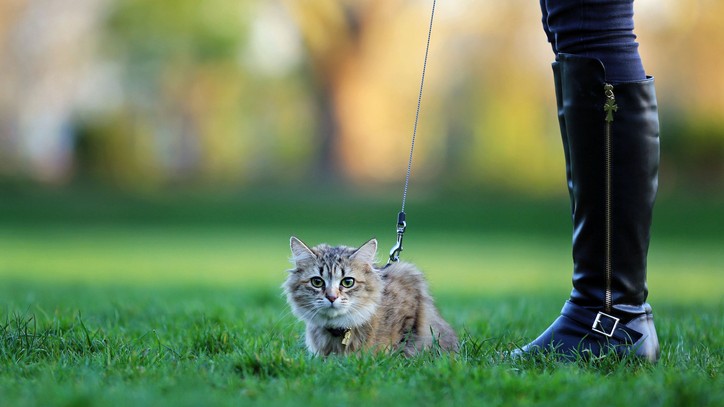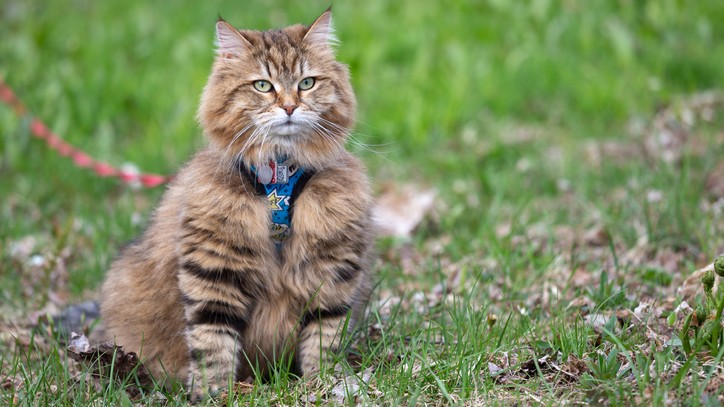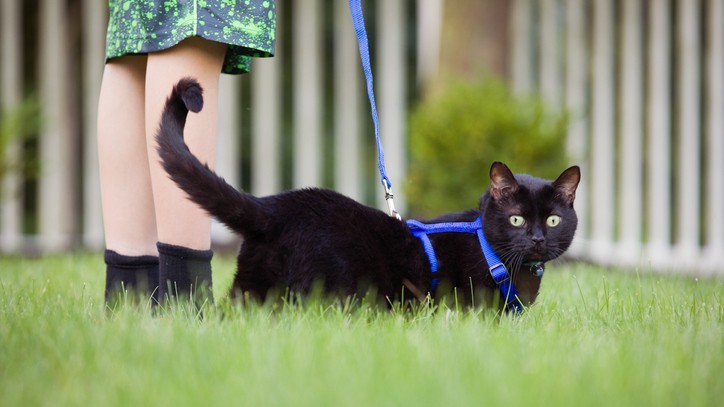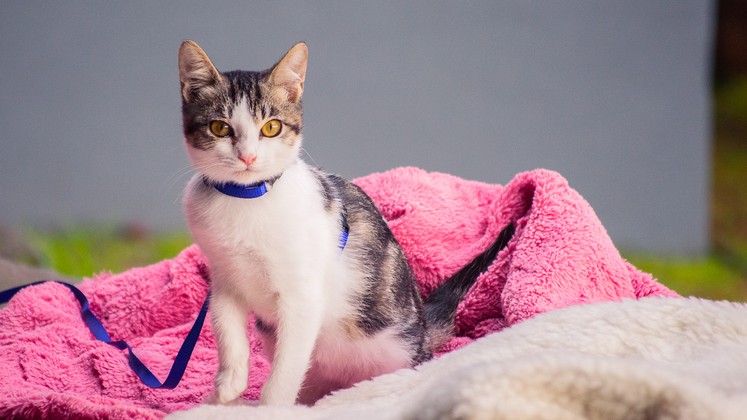How to leash train a cat: A vet's guide to safe walks with your feline
Read our tips on how to leash train a cat so you can keep your feline safe outside

If you’ve ever spotted a cat walking on a leash, you probably stopped to wonder “how do you leash train a cat?”. After all, many people struggle to leash train their dogs – so is leash training a cat even harder?
The good news is, leash training a cat isn’t only for the very best animal trainers – but you will need a fair amount of time, and a cat with a lot of patience. Like all animals, cats learn best with positive reinforcement and will repeat an action that gets them a reward. This makes training them fun!
So, let’s look at the ins and outs of leash training a cat and see if it’s something you might want to do.
Should you leash train a cat?
Of course, the first question is probably ‘should you leash train a cat?’ – followed quickly by ‘why would you need to?’. In some circumstances, having a leash-trained cat means your pet will be able to spend time outdoors safely, without risking themselves or other cats.
Examples might include cats with disabilities such as blindness, cats with infectious diseases like FIV, or cats that aren’t familiar with their environment and could get lost – for example, a cat living aboard a boat or caravan. Training a cat to use a lead and harness means that these cats can all explore the great outdoors in a safe and controlled way.
Advantages of using a cat leash
So, what are the advantages of leash training a cat? Safe access to the outdoors is the main one, but there are others. For instance, training your cat to walk on a leash provides excellent mental stimulation, which reduces behavioral problems and may ward off feline dementia. Another advantage is that you have a greater knowledge of your cat’s bowel movements than with an outdoor cat, meaning you can spot problems and collect samples more easily.
Disadvantages of using a cat leash
Of course, there are disadvantages too. The main one to be aware of is the risk of injury to your cat. Cats naturally try to run or hide from danger, and if they attempt to flee they could hurt themselves on the lead or harness.
Escaped cats can become tangled in their harness, also causing damage. Walking on a leash might also cause some cats stress – they like to be in control of their surroundings, and being restricted might cause them extra anxiety.
If you decide that harness training your cat is a good idea, make sure to tune into your cat’s emotions and respond quickly if you notice them becoming stressed or anxious about the experience.

When to start harness training a kitten or cat
Harness training can take some time, and it’s never too soon to start. Whilst you shouldn’t be leaping to put a harness on your tiny kitten, you can start creating good habits from the minute you bring your kitten home.
For instance, handling your kitten regularly, getting them used to seeing the harness, and training them to a clicker can all be done from day one. Doing this means you’ll have an easier time with harness training once your cat is big enough to fit his harness.
You’ll also need to remember to take your kitten’s health into account – he shouldn’t be going out (even just into your garden!) until he’s fully protected from infectious diseases, fleas, and ticks.
So, there’s no lower limit to when you can start harness training a cat, but you might also be wondering ‘can you leash train an older cat?’. The good news is yes, in most cases, leash training an older cat is perfectly possible – but it will take longer than with a kitten. And, if your older cat is known to suffer from anxiety or stress, you probably shouldn’t be taking them out anywhere unfamiliar.
How long does it take to harness train a cat?
How long harness training takes will depend on your cat’s age, their ability to follow voice commands, and how confident they are, as well as many other things.
If you have a young cat who is outgoing and confident and is already clicker trained, you can train them to accept the harness in just a few days. Lead training will then take a week or two. However, many cats will take longer than this to become confident with using the lead and harness, and some will never take to it.
How to leash train a cat

1. Make the harness interesting
The first step is to get your cat used to the harness by leaving it around the house. If your cat is clicker trained, you can click whenever they show interest in the harness and reward them immediately. You can also try holding the harness out to your cat, and reward them for sniffing, rubbing, or otherwise showing positive interest in it.
2. Try the harness on
Once your cat sees the harness as a positive thing, it’s time to try it on. When your kitty is calm but not asleep, simply slip on the harness. Don’t do it up – you want to be able to get it off quickly.
Give them a treat, then slip the harness back off again. Do this a few times, so that putting the harness on is a fun game. Once that’s sorted, try clipping the harness up, leaving a few seconds, then unclipping and removing. Continue rewarding whenever your cat remains calm, gradually leaving it on for longer.
3. Introduce the leash
Once the harness can stay on without causing stress, it’s time to introduce the leash. Clip it on and try to walk a few steps with your cat. Be careful not to pull on your cat’s lead at all – you want a loose lead at all times. Instead, encourage your cat forward with you by offering treats. Continue walking a few steps at a time, encouraging your cat to walk alongside you with plenty of rewards.
4. Try going a little further
Ideally, you want to use the lead in the garden, but if you don’t have one, a quiet residential area will do – especially if your cat is familiar with it. Encourage your cat to follow you out, leaving the lead slack at all times. If your cat puts the brakes on, back up until they are comfortable. You might need to come back another day to try going a little further. Once outside, sprinkle some treats on the floor, let your cat eat, then head back inside. Remember, taking this slowly is key!
5. Let your cat take the lead
Assuming the main reason you want your cat to walk on a leash is so they can explore, the next step is to allow them to walk in the direction they choose and at their own pace, while loosely holding the lead.
Take plenty of treats so you can reward them regularly for walking nicely. Consider introducing a command word or two – like "time to go home" – to make it easier to communicate with your cat without pulling them around.

How to train your cat to walk without a leash
Of course, if it’s possible to train a cat to walk on a leash, it’s certainly possible to train them to walk without one. However, it’s not a good idea to do this out in public. Whilst it’s a fun training idea for in the home or garden, it’s not safe to walk a cat without a leash in public. If a dog runs at them, their instincts will override their training and they could get lost or hit by a car.
If you decide to train your cat to walk without a leash, the steps are similar to walking with a leash. Simply encourage your cat to follow you by dropping treats regularly, slowly building up to having them walk perfectly at heel before rewarding with the treat.
Conclusion
So, that’s how to leash train a cat. Like many things, it sounds simpler than it is, but it's doable with most cats. However, the most important thing is that you pay close attention to your cat’s mood, stress, body language, and other things. As animals that prefer to run from conflict and stay in familiar surroundings, being on a leash can be scary for a cat. If your cat does appear afraid, get them to a safe place and try again another day.
PetsRadar Newsletter
Get the best advice, tips and top tech for your beloved Pets
After graduating as a vet from the University of Nottingham, Dr Joanna Woodnutt went on to practice companion animal medicine in the Midlands. Since then, she has also written for countless online and print publications and is a regular contributor for Edition Dog Magazine.

